One Step Assembly of Thin Films of Carbon Nanotubes on Screen Printed Interface for Electrochemical Aptasensing of Breast Cancer Biomarker
Abstract
:1. Introduction
2. Experimental Details
2.1. Materials
2.2. Apparatus
2.3. Functionalization of Carbon Nanotubes (CNTs)
2.4. Thin Film Assembly of CNTs on SPCE
2.5. Immobilization of Aptamer on CNTs Modified SPCE
2.6. Electrochemical Impedimetric Measurement
2.7. Analyte Detection, Interference Study and Real Sample Analysis
3. Results and Discussion
3.1. Electrochemical Characterization of the Aptasensor
3.2. Optimization of the Analytical Parameters for Mucine Detection
3.3. Impedimetric Detection of Mucine
3.4. Specificity of Mucine Aptasensor
3.5. Demonstration of the Aptasensor for Clinical Diagnosis
4. Conclusions
Supplementary Materials
Acknowledgments
Author Contributions
Conflicts of Interest
References
- Jariwala, D.; Sangwan, V.K.; Lauhon, L.J.; Marks, T.J.; Hersam, M.C. Carbon nanomaterials for electronics, optoelectronics, photovoltaics, and sensing. Chem. Soc. Rev. 2013, 42, 2824–2860. [Google Scholar] [CrossRef] [PubMed]
- Yan, Q.-L.; Gozin, M.; Zhao, F.-Q.; Cohen, A.; Pang, S.-P. Highly energetic compositions based on functionalized carbon nanomaterials. Nanoscale 2016, 8, 4799–4851. [Google Scholar] [CrossRef] [PubMed]
- Guldi, D.M.; Martin, N. Carbon Nanotubes and Related Structures: Synthesis, Characterization, Functionalization, and Applications; John Wiley & Sons: New York, NY, USA, 2010. [Google Scholar]
- De Volder, M.F.; Tawfick, S.H.; Baughman, R.H.; Hart, A.J. Carbon nanotubes: Present and future commercial applications. Science 2013, 339, 535–539. [Google Scholar] [CrossRef] [PubMed]
- Bard, A.J.; Fan, F.-R.F. Electrochemical detection of single molecules. Acc. Chem. Res. 1996, 29, 572–578. [Google Scholar] [CrossRef]
- Nie, S.; Emory, S.R. Probing single molecules and single nanoparticles by surface-enhanced Raman scattering. Science 1997, 275, 1102–1106. [Google Scholar] [CrossRef] [PubMed]
- Lu, H.P.; Xun, L.; Xie, X.S. Single-molecule enzymatic dynamics. Science 1998, 282, 1877–1882. [Google Scholar] [CrossRef] [PubMed]
- O’Connell, M.J.; Boul, P.; Ericson, L.M.; Huffman, C.; Wang, Y.; Haroz, E.; Kuper, C.; Tour, J.; Ausman, K.D.; Smalley, R.E. Reversible water-solubilization of single-walled carbon nanotubes by polymer wrapping. Chem. Phys. Lett. 2001, 342, 265–271. [Google Scholar] [CrossRef]
- Tasis, D.; Tagmatarchis, N.; Georgakilas, V.; Prato, M. Soluble carbon nanotubes. Chem. A Eur. J. 2003, 9, 4000–4008. [Google Scholar] [CrossRef] [PubMed]
- Hu, C.; Hu, S. Carbon nanotube-based electrochemical sensors: Principles and applications in biomedical systems. J. Sens. 2009, 187615. [Google Scholar] [CrossRef]
- Tasis, D.; Tagmatarchis, N.; Bianco, A.; Prato, M. Chemistry of carbon nanotubes. Chem. Rev. 2006, 106, 1105–1136. [Google Scholar] [CrossRef] [PubMed]
- Park, H.; Afzali, A.; Han, S.-J.; Tulevski, G.S.; Franklin, A.D.; Tersoff, J.; Hannon, J.B.; Haensch, W. High-density integration of carbon nanotubes via chemical self-assembly. Nat. Nanotechnol. 2012, 7, 787–791. [Google Scholar] [CrossRef] [PubMed]
- Lobez, J.M.; Afzali, A. Surface-selective directed assembly of carbon nanotubes using side-chain functionalized poly(thiophene)s. Chem. Mater. 2013, 25, 3662–3666. [Google Scholar] [CrossRef]
- Lee, L.; Ma, H.; Brooksby, P.A.; Brown, S.A.; Leroux, Y.R.; Hapiot, P.; Downard, A.J. Covalently anchored carboxyphenyl monolayer via aryldiazonium ion grafting: A well-defined reactive tether layer for on-surface chemistry. Langmuir 2014, 30, 7104–7111. [Google Scholar] [CrossRef] [PubMed]
- Lobez, J.M.; Han, S.-J.; Afzali, A.; Hannon, J.B. Surface selective one-step fabrication of carbon nanotube thin films with high density. ACS Nano 2014, 8, 4954–4960. [Google Scholar] [CrossRef] [PubMed]
- Baruch, A.; Hartmann, M.-L.; Yoeli, M.; Adereth, Y.; Greenstein, S.; Stadler, Y.; Zaretsky, J.; Smorodinsky, N.I.; Keydar, I.; Wreschner, D.H. The breast cancer-associated MUC1 gene generates both a receptor and its cognate binding protein. Cancer Res. 1999, 59, 1552–1561. [Google Scholar] [PubMed]
- Murray, C.J.; Lopez, A.D. Mortality by cause for eight regions of the world: Global Burden of Disease Study. Lancet 1997, 349, 1269–1276. [Google Scholar] [CrossRef]
- Tothill, I.E. Biosensors for cancer markers diagnosis. Semin. Cell Dev. Biol. 2009, 20, 55–62. [Google Scholar] [CrossRef] [PubMed]
- Duffy, M.J. Serum tumor markers in breast cancer: Are they of clinical value? Clin. Chem. 2006, 52, 345–351. [Google Scholar] [CrossRef] [PubMed]
- He, Y.; Lin, J.; Kong, D.; Huang, M.; Xu, C.; Kim, T.-K.; Etheridge, A.; Luo, Y.; Ding, Y.; Wang, K. Current state of circulating microRNAs as cancer biomarkers. Clin. Chem. 2015, 61, 1138–1155. [Google Scholar] [CrossRef] [PubMed]
- Volinia, S.; Galasso, M.; Sana, M.E.; Wise, T.F.; Palatini, J.; Huebner, K.; Croce, C.M. Breast cancer signatures for invasiveness and prognosis defined by deep sequencing of microRNA. Proc. Natl. Acad. Sci. USA 2012, 109, 3024–3029. [Google Scholar] [PubMed]
- Fu, S.W.; Chen, L.; Man, Y. miRNA biomarkers in breast cancer detection and management. J. Cancer 2011, 2, 116–122. [Google Scholar] [CrossRef] [PubMed]
- Shamsipur, M.; Farzin, L.; Tabrizi, M.A.; Molaabasi, F. Highly sensitive label free electrochemical detection of VGEF 165 tumor marker based on “signal off” and “signal on” strategies using an anti-VEGF 165 aptamer immobilized BSA-gold nanoclusters/ionic liquid/glassy carbon electrode. Biosens. Bioelectron. 2015, 74, 369–375. [Google Scholar] [CrossRef] [PubMed]
- Zhao, J.; He, X.; Bo, B.; Liu, X.; Yin, Y.; Li, G. A “signal-on” electrochemical aptasensor for simultaneous detection of two tumor markers. Biosens. Bioelectron. 2012, 34, 249–252. [Google Scholar] [CrossRef] [PubMed]
- Zhao, S.; Yang, W.; Lai, R.Y. A folding-based electrochemical aptasensor for detection of vascular endothelial growth factor in human whole blood. Biosens. Bioelectron. 2011, 26, 2442–2447. [Google Scholar] [CrossRef] [PubMed]
- Ravalli, A.; Rivas, L.; De La Escosura-Muñiz, A.; Pons, J.; Merkoçi, A.; Marrazza, G. A DNA aptasensor for electrochemical detection of vascular endothelial growth factor. J. Nanosci. Nanotechnol. 2015, 15, 3411–3416. [Google Scholar] [CrossRef] [PubMed]
- Cao, Y.; Chen, D.; Chen, W.; Yu, J.; Chen, Z.; Li, G. Aptamer-based homogeneous protein detection using cucurbit [7] uril functionalized electrode. Anal. Chim. Acta 2014, 812, 45–49. [Google Scholar] [CrossRef] [PubMed]
- Carvalho, I.; Milanezi, F.; Martins, A.; Reis, R.M.; Schmitt, F. Overexpression of platelet-derived growth factor receptor α in breast cancer is associated with tumour progression. Breast Cancer Res. 2005, 7, R788. [Google Scholar] [CrossRef] [PubMed] [Green Version]
- Deng, K.; Xiang, Y.; Zhang, L.; Chen, Q.; Fu, W. An aptamer-based biosensing platform for highly sensitive detection of platelet-derived growth factor via enzyme-mediated direct electrochemistry. Anal. Chim. Acta 2013, 759, 61–65. [Google Scholar] [CrossRef] [PubMed]
- Bai, L.; Yuan, R.; Chai, Y.; Zhuo, Y.; Yuan, Y.; Wang, Y. Simultaneous electrochemical detection of multiple analytes based on dual signal amplification of single-walled carbon nanotubes and multi-labeled graphene sheets. Biomaterials 2012, 33, 1090–1096. [Google Scholar] [CrossRef] [PubMed]
- Wang, J.; Meng, W.; Zheng, X.; Liu, S.; Li, G. Combination of aptamer with gold nanoparticles for electrochemical signal amplification: Application to sensitive detection of platelet-derived growth factor. Biosens. Bioelectron. 2009, 24, 1598–1602. [Google Scholar] [CrossRef] [PubMed]
- Degefa, T.H.; Kwak, J. Label-free aptasensor for platelet-derived growth factor (PDGF) protein. Anal. Chim. Acta 2008, 613, 163–168. [Google Scholar] [CrossRef] [PubMed]
- Zhang, Y.-L.; Huang, Y.; Jiang, J.-H.; Shen, G.-L.; Yu, R.-Q. Electrochemical aptasensor based on proximity-dependent surface hybridization assay for single-step, reusable, sensitive protein detection. J. Am. Chem. Soc. 2007, 129, 15448–15449. [Google Scholar] [CrossRef] [PubMed]
- Lai, R.Y.; Plaxco, K.W.; Heeger, A.J. Aptamer-based electrochemical detection of picomolar platelet-derived growth factor directly in blood serum. Anal. Chem. 2007, 79, 229–233. [Google Scholar] [CrossRef] [PubMed]
- Bast, R.; Bates, S.; Bredt, A.; Desch, C.; Fritsche, H.; Fues, L.; Locker, G.Y. Clinical practice guidelines for the use of tumor markers in breast and colorectal cancer. J. Clin. Oncol. 1996, 14, 2843–2877. [Google Scholar]
- Kirnarsky, L.; Prakash, O.; Vogen, S.M.; Nomoto, M.; Hollingsworth, M.A.; Sherman, S. Structural effects of O-glycosylation on a 15-residue peptide from the mucin (MUC1) core protein. Biochemistry 2000, 39, 12076–12082. [Google Scholar] [CrossRef] [PubMed]
- Taylor-Papadimitriou, J.; Burchell, J.M.; Plunkett, T.; Graham, R.; Correa, I.; Miles, D.; Smith, M. MUC1 and the immunobiology of cancer. J. Mammary Gland Biol. Neoplasia 2002, 7, 209–221. [Google Scholar] [CrossRef] [PubMed]
- Gendler, S.J. MUC1, the renaissance molecule. J. Mammary Gland Biol. Neoplasia 2001, 6, 339–353. [Google Scholar] [CrossRef] [PubMed]
- Dokurno, P.; Bates, P.A.; Band, H.A.; Stewart, L.M.; Lally, J.M.; Burchell, J.M.; Taylor-Papadimitriou, J.; Snary, D.; Sternberg, M.J.; Freemont, P.S. Crystal structure at 1.95 Å resolution of the breast tumour-specific antibody SM3 complexed with its peptide epitope reveals novel hypervariable loop recognition. J. Mol. Biol. 1998, 284, 713–728. [Google Scholar] [CrossRef] [PubMed]
- Taylor-Papadimitriou, J.; Burchell, J.; Miles, D.; Dalziel, M. MUC1 and cancer. Biochim. Biophys. Acta Mol. Basis Dis. 1999, 1455, 301–313. [Google Scholar] [CrossRef]
- Mehla, K.; Singh, P.K. MUC1: A novel metabolic master regulator. Biochim. Biophys. Acta Rev. Cancer 2014, 1845, 126–135. [Google Scholar] [CrossRef] [PubMed]
- Hamanaka, Y.; Suehiro, Y.; Fukui, M.; Shikichi, K.; Imai, K.; Hinoda, Y. Circulating anti-MUC1 IgG antibodies as a favorable prognostic factor for pancreatic cancer. Int. J. Cancer 2003, 103, 97–100. [Google Scholar] [CrossRef] [PubMed]
- Bonanni, A.; Esplandiu, M.; Pividori, M.; Alegret, S.; Del Valle, M. Impedimetric genosensors for the detection of DNA hybridization. Anal. Bioanal. Chem. 2006, 385, 1195–1201. [Google Scholar] [CrossRef] [PubMed]
- Shukla, R.K.; Raina, K.; Hamplová, V.; Kašpar, M.; Bubnov, A. Dielectric behaviour of the composite system: Multiwall carbon nanotubes dispersed in ferroelectric liquid crystal. Phase Trans. 2011, 84, 850–857. [Google Scholar] [CrossRef]
- Rahman, M.J.; Mieno, T. Water-dispersible multiwalled carbon nanotubes obtained from citric-acid-assisted oxygen plasma functionalization. J. Nanomater. 2014, 508192. [Google Scholar] [CrossRef]
- Xie, Y.; He, C.; Liu, L.; Mao, L.; Wang, K.; Huang, Q.; Liu, M.; Wan, Q.; Deng, F.; Huang, H.; et al. Carbon nanotube based polymer nanocomposites: Biomimic preparation and organic dye adsorption applications. RSC Adv. 2015, 5, 82503–82512. [Google Scholar] [CrossRef]
- Hayat, A.; Barthelmebs, L.; Marty, J.-L. Electrochemical impedimetric immunosensor for the detection of okadaic acid in mussel sample. Sens. Actuators B Chem. 2012, 171, 810–815. [Google Scholar] [CrossRef]
- Radi, A.-E.; Acero Sánchez, J.L.; Baldrich, E.; O’Sullivan, C.K. Reusable impedimetric aptasensor. Anal. Chem. 2005, 77, 6320–6323. [Google Scholar] [CrossRef] [PubMed]
- Xu, D.; Xu, D.; Yu, X.; Liu, Z.; He, W.; Ma, Z. Label-free electrochemical detection for aptamer-based array electrodes. Anal. Chem. 2005, 77, 5107–5113. [Google Scholar] [CrossRef] [PubMed]
- Li, C.-Z.; Liu, Y.; Luong, J.H. Impedance sensing of DNA binding drugs using gold substrates modified with gold nanoparticles. Anal. Chem. 2005, 77, 478–485. [Google Scholar] [CrossRef] [PubMed]
- Mishra, R.K.; Hayat, A.; Catanante, G.; Ocaña, C.; Marty, J.-L. A label free aptasensor for Ochratoxin A detection in cocoa beans: An application to chocolate industries. Anal. Chim. Acta 2015, 889, 106–112. [Google Scholar] [CrossRef] [PubMed]
- Yang, G.; Jin, W.; Wu, L.; Wang, Q.; Shao, H.; Qin, A.; Yu, B.; Li, D.; Cai, B. Development of an impedimetric immunosensor for the determination of 3-amino-2-oxazolidone residue in food samples. Anal. Chim. Acta 2011, 706, 120–127. [Google Scholar] [CrossRef] [PubMed]
- Geng, P.; Zhang, X.; Meng, W.; Wang, Q.; Zhang, W.; Jin, L.; Feng, Z.; Wu, Z. Self-assembled monolayers-based immunosensor for detection of Escherichia coli using electrochemical impedance spectroscopy. Electrochim. Acta 2008, 53, 4663–4668. [Google Scholar] [CrossRef]
- Ma, F.; Ho, C.; Cheng, A.K.; Yu, H.-Z. Immobilization of redox-labeled hairpin DNA aptamers on gold: Electrochemical quantitation of epithelial tumor marker mucin 1. Electrochim. Acta 2013, 110, 139–145. [Google Scholar] [CrossRef]
- Hu, R.; Wen, W.; Wang, Q.; Xiong, H.; Zhang, X.; Gu, H.; Wang, S. Novel electrochemical aptamer biosensor based on an enzyme–gold nanoparticle dual label for the ultrasensitive detection of epithelial tumour marker MUC1. Biosens. Bioelectron. 2014, 53, 384–389. [Google Scholar] [CrossRef] [PubMed]
- Taleat, Z.; Cristea, C.; Marrazza, G.; Mazloum-Ardakani, M.; Săndulescu, R. Electrochemical immunoassay based on aptamer–protein interaction and functionalized polymer for cancer biomarker detection. J. Electroanal. Chem. 2014, 717, 119–124. [Google Scholar] [CrossRef]
- Florea, A.; Ravalli, A.; Cristea, C.; Săndulescu, R.; Marrazza, G. An Optimized Bioassay for Mucin1 Detection in Serum Samples. Electroanalysis 2015, 27, 1594–1601. [Google Scholar] [CrossRef]
- Liu, X.; Qin, Y.; Deng, C.; Xiang, J.; Li, Y. A simple and sensitive impedimetric aptasensor for the detection of tumor markers based on gold nanoparticles signal amplification. Talanta 2015, 132, 150–154. [Google Scholar] [CrossRef] [PubMed]
- Wen, W.; Hu, R.; Bao, T.; Zhang, X.; Wang, S. An insertion approach electrochemical aptasensor for mucin 1 detection based on exonuclease-assisted target recycling. Biosens. Bioelectron. 2015, 71, 13–17. [Google Scholar] [CrossRef] [PubMed]
- Chen, X.; Zhang, Q.; Qian, C.; Hao, N.; Xu, L.; Yao, C. Electrochemical aptasensor for mucin 1 based on dual signal amplification of poly (o-phenylenediamine) carrier and functionalized carbon nanotubes tracing tag. Biosens. Bioelectron. 2015, 64, 485–492. [Google Scholar] [CrossRef] [PubMed]
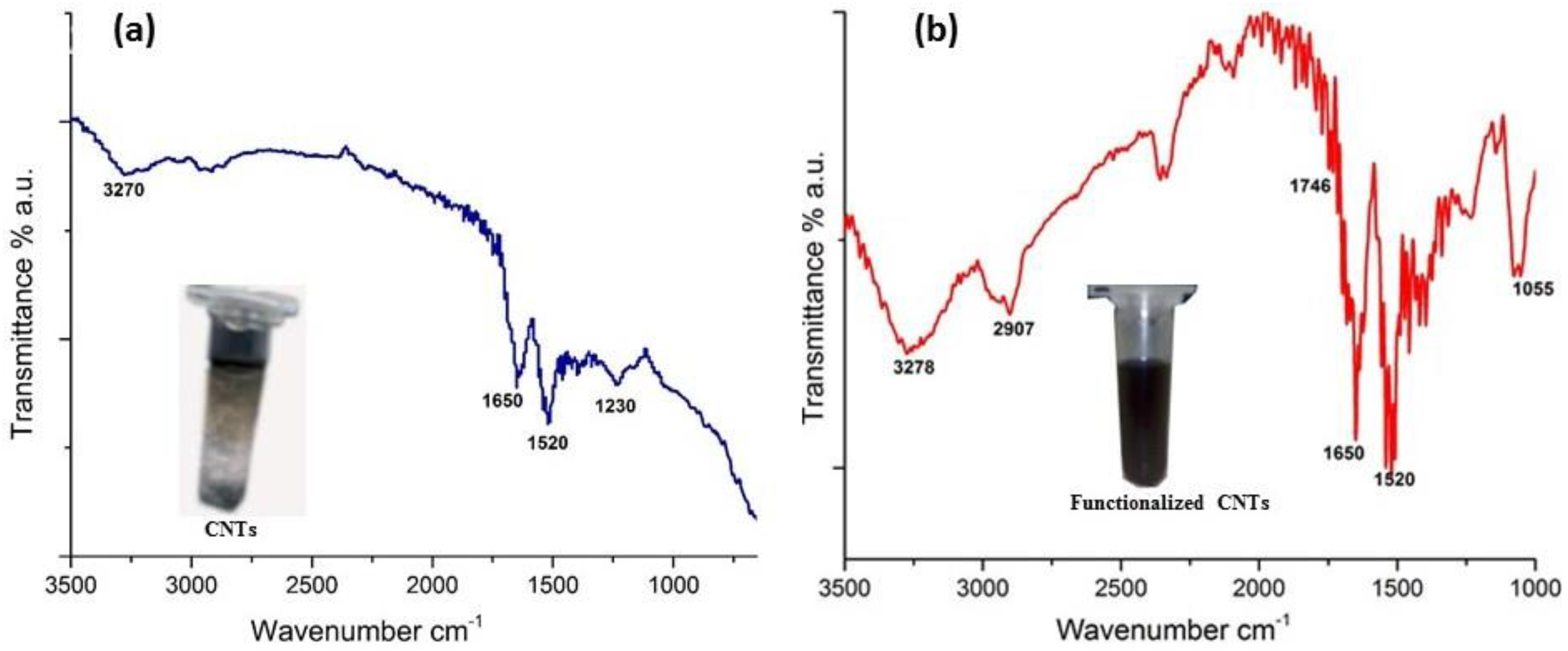
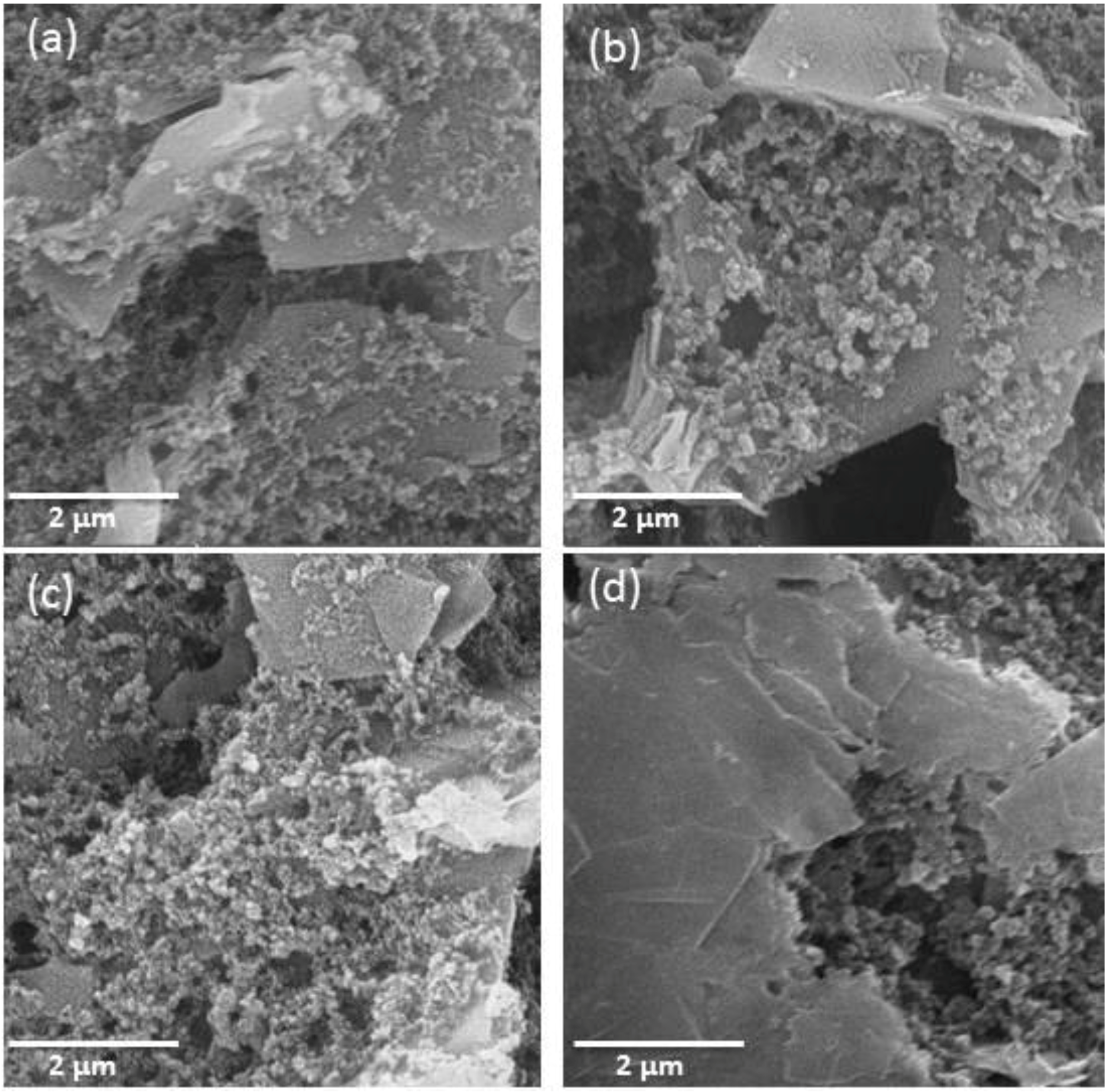
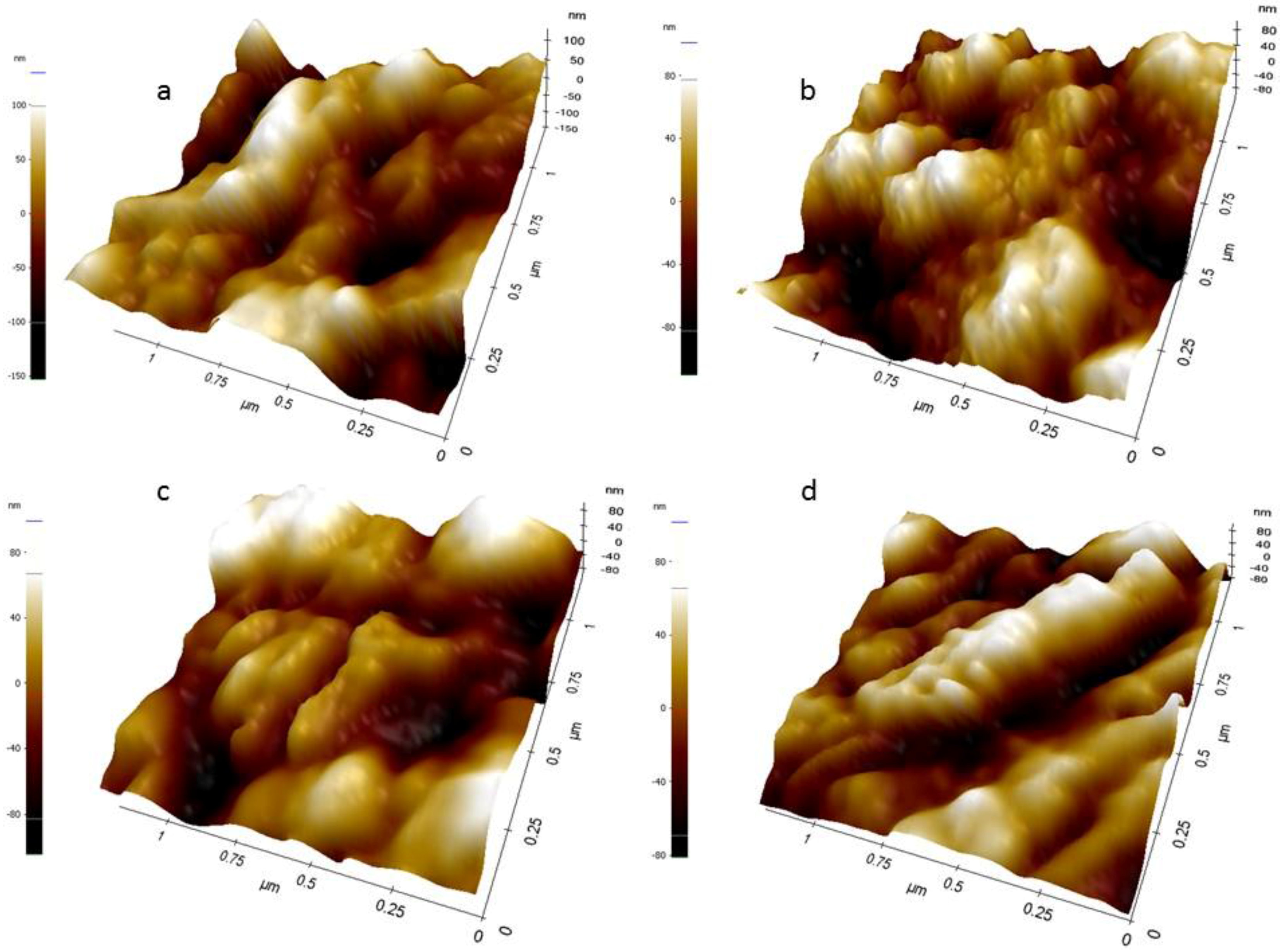
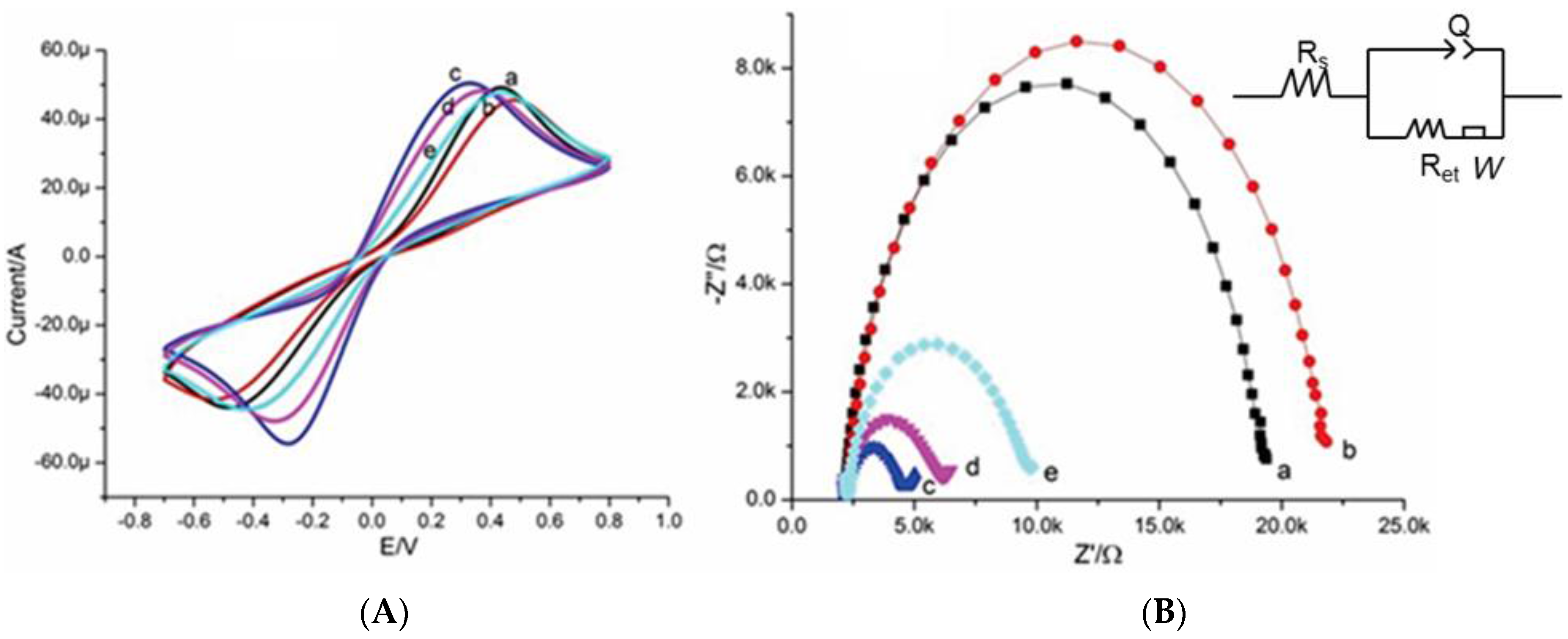
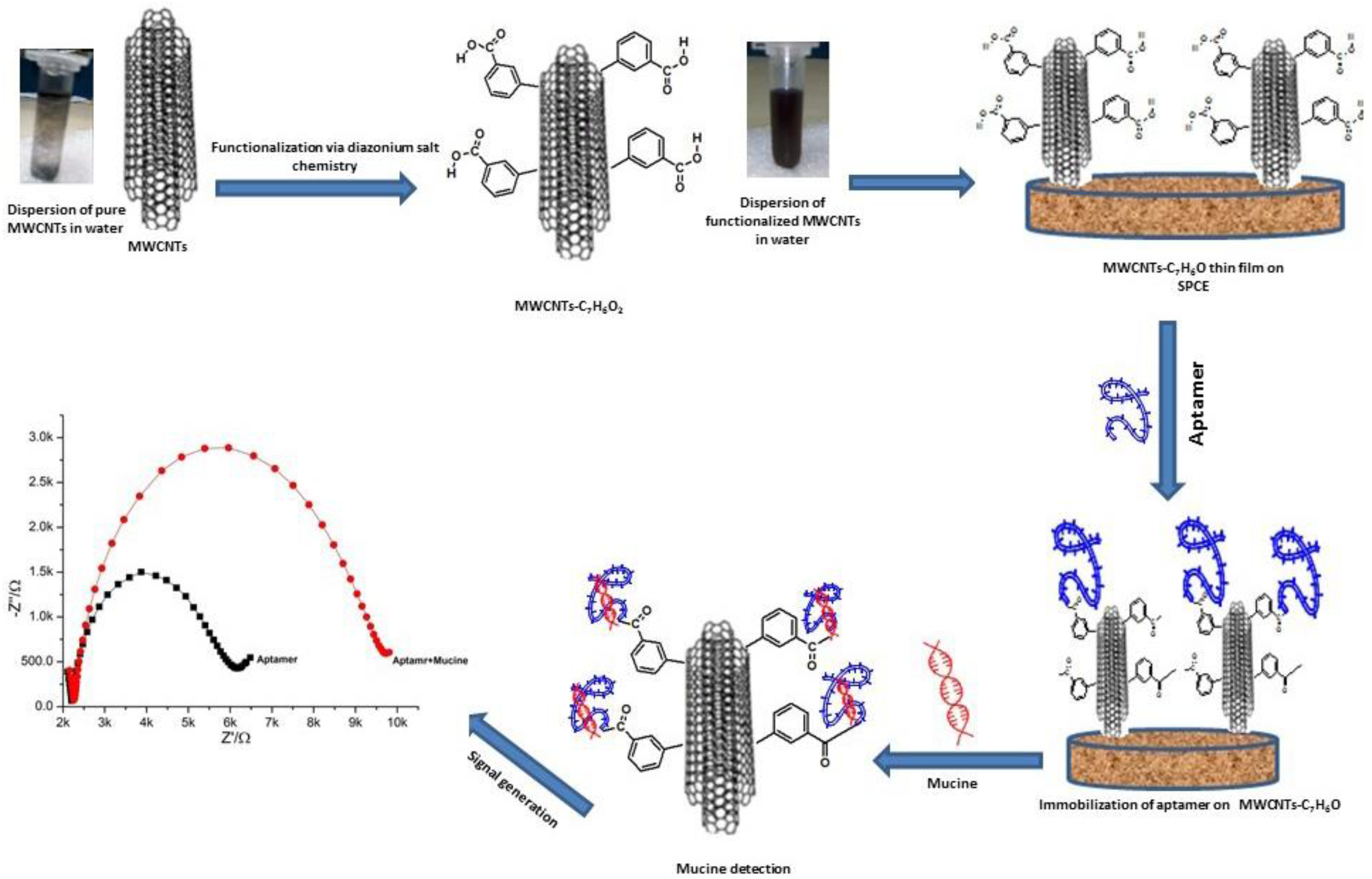

| Sr. No | Method Principal | LOD | Linear Range | Ref. |
|---|---|---|---|---|
| 1 | “Signal-on” electrochemical aptasensor | 0.33 nM | 1–20 nM | [24] |
| 2 | Immobilization of redox-labeled hairpin DNA aptamers on gold | 50 nM | 1.50 µM | [54] |
| 3 | Aptasensor based on enzyme–gold nanoparticle dual label | 2.2 nM | 8.8–353.3 nM | [55] |
| 4 | Electrochemical immunoassay based on aptamer–protein interaction | 0.62 ppb | 1–12 ppb | [56] |
| 5 | Sandwich format based magnetic beads coupling screen-printed arrays | 0.07 nM | 0–0.28 nM | [57] |
| 6 | Impedimetric aptasensor based on gold nanoparticles | 0.1 nM | 0.5–10 nM | [58] |
| 7 | Insertion approach electrochemical aptasensor based on exonuclease-assisted target recycling | 4 pM | 10 pM–1 μM | [59] |
| 8 | dual signal amplification of poly(o-phenylenediamine) carrier and functionalized carbon nanotube tracing tag | 1 pM | 1–100 nM | [60] |
| 9 | Carbon nanotube thin film assembly on Screen Printed Interface | 0.02 U/mL | 0.1–2 U/mL | Present work |
© 2016 by the authors; licensee MDPI, Basel, Switzerland. This article is an open access article distributed under the terms and conditions of the Creative Commons Attribution (CC-BY) license (http://creativecommons.org/licenses/by/4.0/).
Share and Cite
Nawaz, M.A.H.; Rauf, S.; Catanante, G.; Nawaz, M.H.; Nunes, G.; Marty, J.L.; Hayat, A. One Step Assembly of Thin Films of Carbon Nanotubes on Screen Printed Interface for Electrochemical Aptasensing of Breast Cancer Biomarker. Sensors 2016, 16, 1651. https://doi.org/10.3390/s16101651
Nawaz MAH, Rauf S, Catanante G, Nawaz MH, Nunes G, Marty JL, Hayat A. One Step Assembly of Thin Films of Carbon Nanotubes on Screen Printed Interface for Electrochemical Aptasensing of Breast Cancer Biomarker. Sensors. 2016; 16(10):1651. https://doi.org/10.3390/s16101651
Chicago/Turabian StyleNawaz, Muhammad Azhar Hayat, Sajid Rauf, Gaelle Catanante, Mian Hasnain Nawaz, Gilvanda Nunes, Jean Louis Marty, and Akhtar Hayat. 2016. "One Step Assembly of Thin Films of Carbon Nanotubes on Screen Printed Interface for Electrochemical Aptasensing of Breast Cancer Biomarker" Sensors 16, no. 10: 1651. https://doi.org/10.3390/s16101651





